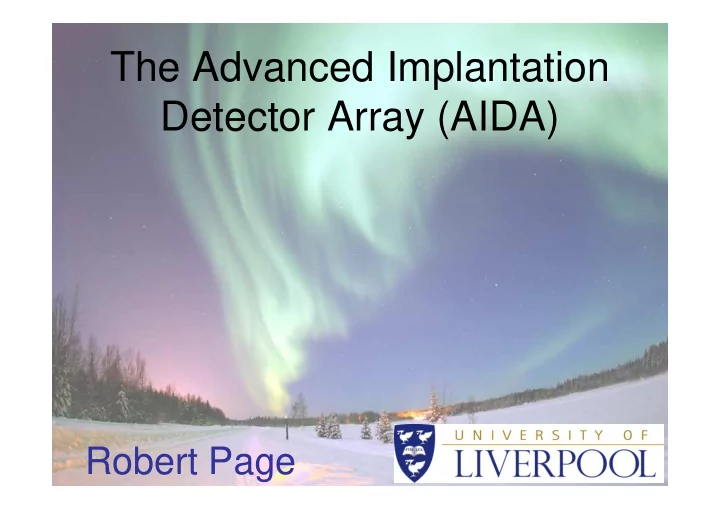

The Advanced Implantation Detector Array (AIDA) Robert Page
The AIDA Project Funded by UK EPSRC/STFC (~£2M) Collaboration between University of Liverpool University of Liverpool University of Edinburgh STFC Daresbury Laboratory STFC Rutherford Appleton Laboratory Part of the wider DESPEC collaboration within NUSTAR at GSI/FAIR
FAIR context
Super FRS Advanced Implantation Detector Array (AIDA) DEcay SPECtroscopy (DESPEC)
FRS vs. Super FRS
Predicted Super FRS Yields @ 10 12 /s c number Z → Atomic nu = 3.6 / hour Neutron number N → = 0.6 / week
A & Z separation Isomer γ decays for unique A & Z identification
Experimental concept 3 He proportional counters AIDA ion beam AIDA β decay n n 3 He proportional counters Moderator block (polyethylene) Moderator block (polyethylene) Side view Front view Segmented Si detector (DSSD) for ion- β correlations
Predicted Super FRS Yields @ 10 12 /s c number Z → Atomic nu = 3.6 / hour Neutron number N → = 0.6 / week
AIDA design – some criteria 1. Highly segmented for reliable ion- β correlations at high rates 2. Low energy threshold (50 keV) for high β detection efficiency 3. Large energy range to measure ion energies (20 GeV) too!! 4. Many Si planes to stop all ions (~10 mm thickness) 5. Active area to cover (Super) FRS focal plane or single nuclide 6. Compact to fit inside neutron array, RISING Ge array, … 7. Minimum material – n, γ absorption/scattering 8. Good time resolution for n time of flight, … 9. Measure decays within ~ µ s of ion implantation! 10. Spectroscopic performance for decays
AIDA Design “standard” configuration “compact” configuration 24 cm x 8 cm 8 cm x 8 cm Si thickness = 1 mm, strip pitch = 625 µ m, >5000 channels
Compatibility with neutron array BELEN 28 → 44
Compact configuration DSSDs ASICs + FEE cards
Compatibility with RISING
Compatibility with future Ge array
AIDA ASIC Design
AIDA ASIC Design
AIDA ASIC
AIDA ASIC & readout Mezzanine card: FEE card: 4x 16 channel ASICs 4x 16-bit ADC MUX readout (not visible) Cu cover 8x octal 50MSPS 14-bit ADCs EMI/RFI/light screen Xilinx Virtex 5 FPGA cooling PowerPC 40x CPU core – Linux - MIDAS FEE card width: 8cm Gbit ethernet, clock, Prototype – air cooling JTAG ports, power Production – recirculating coolant
Packaged AIDA FEE cards
AIDA clock box Master SYNC to clock box FEE64 (sync master) Clock FEE64 box FEE64 For operating >1 AIDA FEE64 FEE64 Module may be cascaded 200MHz clock and SYNC distribution
Commissioning experiments – β -delayed proton emitters TAMU – MARS – α emitters with N~126 – α emitters with N~126 GSI GSI ( 219-223 U, 218-221 Pa, 216-220 Th) or 109 I & 106 Te – FRS
Status Summary Mechanical assembly of prototype complete Thermal tests of DSSD cooling ongoing Bench tests of ASICs, FEE cards ongoing pulsers → electron sources pulsers → electron sources Commissioning experiments soon (?) First experimental proposals to GSI PAC Further information: http://www.ph.ed.ac.uk/~td/AIDA
Collaborators R.D. Page, T. Grahn, University of S. Rinta-Antila, D.A. Seddon Liverpool T. Davinson, Z.Liu, University of P.J. Woods P.J. Woods Edinburgh Edinburgh P.J. Coleman-Smith, I.H. Lazarus, STFC S.C. Letts, P. Morrall, V.F.E. Pucknell, Daresbury J. Simpson, J. Strachan Laboratory D. Braga, M. Prydderch, S.L. Thomas STFC RAL
Recommend
More recommend